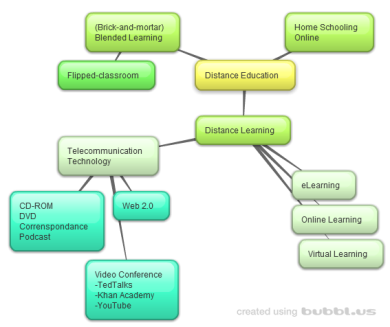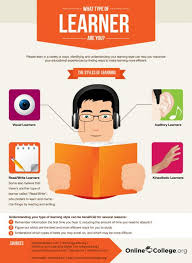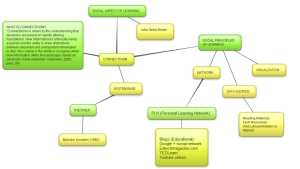Introduction
Learning Theories and Instruction introduced me to the world of learning from the inside-out. We began with the brain and its many functions and continued with the theories, behaviorism, cognitivism, constructivism, and social constructivism, Connectivism. These theories are the basis to instruction design but not the only elements needed to understand the learning process. Adult learning (Andragogy), the learning strategies and learning styles gave me a deeper understand to how I learn and why I find some course material more interesting than others with motivation and technology assisting with the progression of learning experience.
As I furthered my knowledge about how people learned, Designing Effective Adult Learning Experiences directed me in a different direction towards the implementation of individual learning. Self-directed learning, “it is defined as the process in which individuals take on the responsibility for their own learning process by diagnosing their personal learning needs, setting goals, identifying resources, implementing strategies and evaluating the outcomes.” (Conlan, J., Grabowski, S., & Smith, K. (2003). Malcolm Knowles (1980) made four assumptions about adults as learners: (1) Adults tend to be more self-directed as a result of their maturity, (2) Adults possess personal histories which defines their identities and serve as a resource of experiential learning upon which new learning’s can be applied, (3) Motivation in adults is directed to more socially relevant learning, and (4) Adult learners have interest in immediate application for problem-solving. Knowles, andragogy is distinct from Pedagogy. (Knowles, 1980) My personal learning experiences have been deepened by several different topics throughout this course.
One in particular was in week 2. In understanding how the brain processes information, we discussed how the brain store information (encoding) and understanding the different parts of the forebrain, such as the Limbic system that is located inside and below the cortex, that identifies what may be occurring, “this part of the forebrain is essential to learning, memory, emotion, and motivation.” (Adolphs & Damasio, 2001; Cahill et al., 1996) I was fascinated by the findings.
Recognizing Learning Style Differences, Elaboration, comprehension monitoring, and mnemonics effective learning strategies were “eye-opener” for me. Dr. Ormrod explains their meaning; Elaboration, and it simply means that you take information—new information about whatever topic—and you do something with it mentally.”We aren’t good verbatim learners. We’re very good elaborators. And helping adult learners and child learners understand that can take them a long way.” (Ormrod, Laureate Education, Inc.), Comprehension monitoring, what we simply mean is that as learners, we stop periodically and check ourselves. “Did I understand that…?” (Ormrod, Laureate Education, Inc.), Mnemonics, and the fact is, much as we would like to be able to make sense out of everything we learn, we can’t always. Certain things just don’t necessarily make sense.” (Ormrod, Laureate Education, Inc.) Another interesting topic during my learning progression, “As more and more people receive their information from films, television, DVD’s and online sources, the value placed on having a strong spatial intelligence may increase.” (Armstrong, p. 13) For Integrating Emerging Technologies into Instruction, I’ve learned that the NMC Horizon Report for Higher Ed., 2014, Quantified Self is used to collect technological data from mobile devices. “Quantified self technologies tap into this interest in the form of mobile apps, wearable devices, and cloud-based services that make the data collection process much easier.” (NMC Horizon Report, 2014) And finally, Motivational Factors in the Online Classroom. Where Motivational factors and its level of importance in learning were identified and how the implementation of Keller’s ARCS model is used to design an effective online class structure.
My learning in this course provided me with the ground work needed in the area of instructional design by focusing on the Learning Matrix used as a guideline of the learning process and the use of the Keller’s ARCS model when designing online programs.
Conclusion
The Learning Theories Matrix and the Keller’s ARCS model provided an overall view of the learning process that focuses on the theories, adult learning styles and strategies used to design an effective online program through technology. Having that knowledge will be beneficial so that a curriculum can be designed based on the learner’s way of processing information.
References
Ormrod, J., Schunk, D., & Gredler, M. (2009). Learning theories and instruction (Laureate custom edition). New York: Pearson.
Ertmer, P. A., & Newby, T. J. (1993). Behaviorism, cognitivism, constructivism: Comparing critical features from an instructional design perspective. Performance Improvement Quarterly
Video Program: Laureate Education (Producer). (n.d.). An introduction to learning [Video file]. Retrieved from https://class.waldenu.edu Dr. Jeanne Ormrod
Kerr, Bill blog. “_isms as Filler Not Blinker. Retrieved from
http://billkerr2.blogspot.com/2007/01/isms-as filter-not-blinker.html
Kapp, Karl blog, Out and About Discussion on Educational School of Thought. Retrieved from http://karlkapp.blogspot.com/2007/01/out-and-about-discussion-on-educational.html
Armstrong, T. (2009). Multiple intelligences in the classroom (3rd ed.). Alexandria, VA: Association for Supervision and Curriculum Development.Available in the Walden Library databases. Chapter 1, “The Foundations of the Theory of Multiple Intelligences” Chapter 2, “MI and Personal Development”
Gilbert, J., & Swanier, C. (2008). Learning styles: How do they fluctuate? Institute for Learning Styles Journal [Vol. l]. Retrieved from http://www.auburn.edu/~witteje/ilsrj/Journal%20Volumes/Fall%202008%20Volume%201%20PDFs/Learning%20Styles%20How%20do%20They%20Fluctuate.pdf
Howard Gardner’s Web site: Retrieved from http://howardgardner.com/
NMC Horizon Report (2014) Higher Education Edition. Retrieved from http://www.nmc.org/publication/nmc-horizon-report-2014-higher-education-edition/
Tech to Learn: Blended Learning. Retrieved from http://www.edutopia.org/tech-to-learn-blended-learning-video
Teaching, Learning, Resources. ARCS Model, Motivational Design. Retrieved from http://teachinglearningresources.pbworks.com/w/page/19919538/ARCS%20Model%20of%20Motivational%20Design
Edutopia. Retrieved from http://www.edutopia.org/
Foley, G. (Ed.). (2004). Dimensions of adult learning: Adult education and training in a global era. McGraw-Hill Education. (Note: This title is available in the eBooks area of the Walden Library. Search ebrary for this title.)
Chapter 4, “Understanding Adult Learners” by Tara Fenwick and Mark Tennant
Chapter 11, “On-line Adult Learning” by Bruce Spencer
Conlan, J., Grabowski, S., & Smith, K. (2003). Adult learning. In M. Orey (Ed.), Emerging perspectives on learning, teaching, and technology. Retrieved from http://projects.coe.uga.edu/epltt/index.php?title=Adult_Learning*


